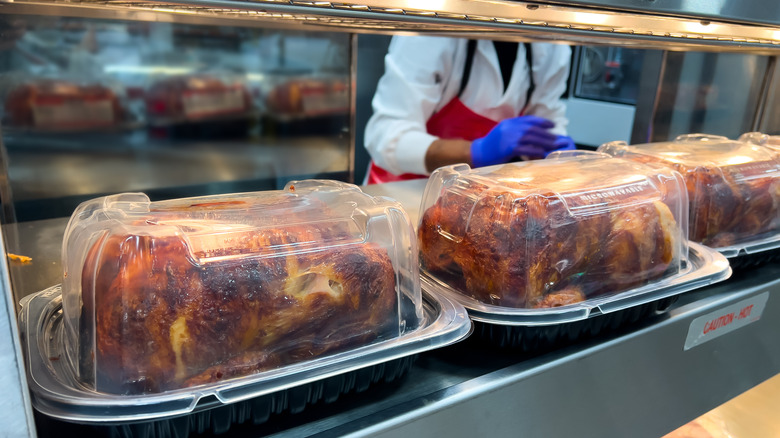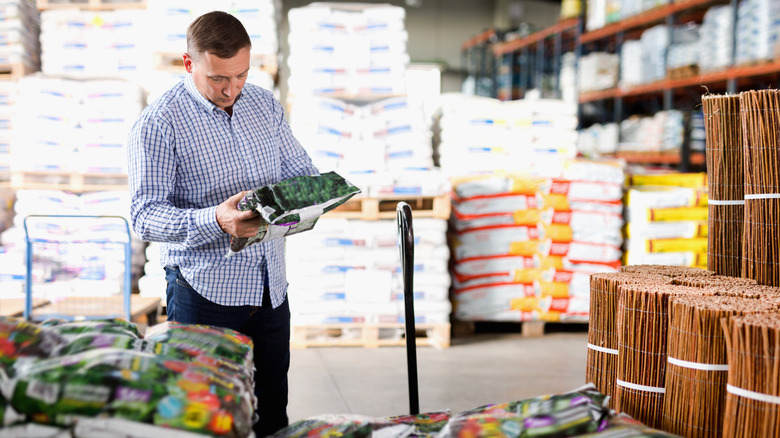Reuse Leftover Rotisserie Chicken Containers In An Unexpected Way For Your Garden
Whether you're urban farming veggies or cultivating a button-cute succulent garden, you know that the need for containers to grow things in is pretty much endless. After all, you've got seeds to start and cuttings to root, and those activities require something waterproof and decently sturdy to hold soil in. Here's some good news for gardeners amid rising inflation costs: that rotisserie chicken you buy at Costco or your nearest supermarket chain has more uses than just eating — or, at least, the packing it comes in does. Punch a few holes in the bottom of the solid plastic bottom and you have a great planter on your hands. Pop the clear plastic top back on to create a mini greenhouse or protect vulnerable seedlings from pests.
It's particularly appealing that this idea is literally free — especially if you eat a lot of rotisserie chicken (and let's be frank, if you eat meat, you probably do). What's more, you get to bask in those feel-good vibes generated by saving yet another bit of plastic from the landfill and, potentially, our oceans. Practically, the container performs this second-life task really well. The transparent plastic lid lets sunlight into the interior while trapping moisture inside (you'll see condensation collect on the lid), creating the humid environment that seeds and cuttings trying hard to put out roots love. It's also relatively lightweight, making it easy to move around depending on sunlight needs.
Gather your materials
This may be the best way to start seeds indoors you'll find anywhere, but before you can put the DIY method into practice, you need supplies. Get a rotisserie chicken (or, more aptly, its container) from Costco or a local supermarket. Any size will work — smaller trays are great for a few cuttings, while larger boxes work for seed germination. Use two containers to create a self-watering planter: one container with drainage holes sits atop a second without. You'll also need scissors, an awl, or a drill with a half-inch bit to create your drainage holes (without these, the soil in your starter box will get too soggy and drown or rot your seeds or seedlings).
Seeds benefit from specialist soil, like Miracle-Gro Seed Starting Mix, which costs $6.98 for an 8-quart bag at Lowe's. Try Soil Sunrise plant propagation potting mix for cuttings — a 4-quart bag is $16.99 at Walmart. To improve drainage, get some fine gravel — think aquarium stones — to line the container. Invest in some blank plant labels to help you keep track of which seeds you've planted where. Fill a spray bottle with fresh water. Optional supplies include something to house seeds (called "seedling cells"), from Jiffy pellets and non-woven nursery bags to Dixie cups (with drainage holes poked in the bottom) or toilet rolls cut down to size; vermiculite to cover the seeds; and rubber bands to keep the lid on outdoor containers and protect your plants from hungry herbivores.
Get making your upcycled grow box
So, how to start a mini greenhouse in a leftover plastic rotisserie chicken container? First, wash the container using hot water and dish soap. Remove the transparent plastic lid and cut, drill, or punch drainage holes in the base — seven eraser-sized openings at minimum. Fill the base with gravel and then top that with potting soil or mix. Sow your seeds or plant your cuttings, and insert a plant label at one end if you're using one. Alternatives include microgreens, a great way to use old vegetable seeds from past seasons, or a succulent or fern and moss terrarium. Add sand and perlite or pumice to your potting mix if growing succulents.
Cut a hole in the lid if you want to release some condensation and make watering easier — you don't have to remove the lid to water. To separate your seeds for easy seedling transplant once sprouted, replace the gravel in the base with homemade or store-bought seedling cells, then add the soil. Sow up to 10 seeds or plant a single cutting into each cell. Thoroughly water the potting mix and snap the transparent lid onto the base. Place your mini-greenhouse in a warm spot until the seeds sprout or cuttings take root, then move it into full sun, outside or in, until the seedlings are ready to plant into your garden beds or repot into bigger planters. Water occasionally to keep the soil damp — two times a week or less.

